What is Google Display Network?
The Google Display Network is a collection of over 200 million sites, apps, and videos where your Google ads can appear. As this network reaches 90% of global internet users, joining will greatly increase the number of eyes on your ads.
Why use the Google Display Network?

The value for GDN boils right down to reach and affordability. Prospecting, brand awareness, and remarketing can come with a hefty price tag when pursued for traditional search ads. GDN, by comparison, bypasses a lot of costly competition from other networks.
With Google's search ads, you're essentially throwing out a wide net, which can be largely hit-or-miss, both with whom you're targeting and with how you're spending.
Is it better to use GDN over search?
Whether or not you should choose GDN over search ads largely depends on your marketing goals. Generally, you’ll want to use GDN when the goal is to build brand awareness in a more cost-effective way.
There’s less competition for inflated keyword bids, so you're more likely to reach users actively searching for your products and services. Though the audience intent is not as strong, you get a much lower cost-per-click and many more impressions. There are also endless options for customizing your audience targeting.
Ultimately, you don’t need a fat wallet to set up a campaign through Google Display — you just need to choose the right targeting factors for your marketing goal.
Google's Display Network allows you to define your audience in a way search engines can't. Since you can target more than just keywords, you aren't limited to the Google results page. Instead, GDN allows you to target websites by audience affinities, in-market segments, and custom intent keywords. You can even hand-pick website placements that fit your target audience.
The other differentiator is volume. Where do the fancy image ads appear when you market with GDN? Across millions of websites that your prospects are visiting every day.
But really – what's the difference between GDN and a simple search ad? Let's explore that, now.
Google Search vs. Display Network
You need a different mentality when using Google's Display Network than when you're using the search network and others available on Google Ads. Let's define some use cases and expectations.

According to a study from Wordstream, the average GDN click-through- rate (CTR) was just 0.46% compared to 3.17% across search. This may seem minuscule, but it’s important to note this is because you're targeting users that may not be familiar with your brand at all. The Google Display Network is first and foremost a tool for prospecting and brand awareness.
The standard CTR for this network is still under 0.5%. But, for targeting prospects outside of search engines and social networks, that's still pretty good.

The next key differentiator is the fact that the user's primary interest is the website content itself — the display ad has an indirect, secondary role in the website's appeal to the viewer.
Marketers are hoping the prospective user will view their GDN ad along their journey to fulfilling another purpose. That makes the user intent different than when an ad appears at the top of a Google results page for a high-intent search phrase. It should be no surprise that the click-through rate and conversion rate for GDN are below 1%.
Unlike with search, there is a variety of targeting options outside of keywords that span across a network of millions of websites. You can access the majority of internet users through website placements. Your number-one goal with GDN is finding the right audience size with strict targeting criteria.
There are ways to approach this network with tighter, more relevant targeting. Ultimately, remarketing is limitless — but it involves audience development outside the Google Ads platform. Let's start by exploring the default prospecting options Google provides and work our way toward opportunities customized for your brand and those who have engaged with your website.
Google Display Network Remarketing or Prospecting?
On the GDN, you can target in two ways. First, you can target prospects on the internet who may have no previous knowledge of your website, brand, products, or services. Second, you can remarket to users who have engaged with your website in some form. Option two allows you to leverage the audiences you find in Google Analytics for your website. If you don't have any Google Analytics website audiences built, doing so is incredibly easy — simply set up an audience for a user that completes specific actions.
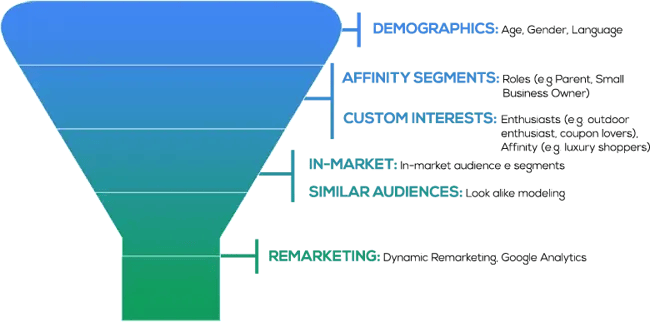
Some of the most common remarketing audiences include:
- General website visitors
- Users who have submitted a form
- Users who have downloaded content
- Users who have viewed specific product pages
- Users who have signed up for an account or trial offer
- Users who have completed a transaction or purchased a product
- Users who have begun any of the above actions but abandoned the page before completing it
Remarketing and prospecting are two vastly different initiatives that you can execute through GDN. Some businesses prefer to focus only on remarketing because reaching users familiar with one's brand drives leads and sales for the most affordable cost. However, other businesses aren't focused on the return as much as generating awareness of their products and services. It all comes down to your company's marketing goals.
Google Display Ad Examples
Once you know how to target, you'll want to create the collateral that gets the attention you need from your ad placements. Here are some great examples of Google display ads:
1. SEMrush

SEMrush uses large white font across an eye-catching blue background with bold oranges and pinks, making it colorful and stark enough to attract attention.
Why We Like It
- The copy of this ad does two things: states the value ("skyrocket your marketing") and provides social proof ("like our clients did")
2. Conversica

Conversica utilizes the large vertical format, which takes up a lot of real estate space on a page, enough to hopefully stir any website visitors out of "banner blindness." Their strategy is not to promote their company but rather an offer: research on virtual assistants in sales.
Why We Like It
-
The vertical ad is large enough to catch the attention of the person browsing the site, plus entices them with an offer rather than a hard sell.
3. E*TRADE

This is one of the skinnier horizontal banners, and E*TRADE uses it to make a bold statement: "$0 commissions" in large letters across the center. The call to action (open an account) is much smaller than the value proposition so that they recognize the value first before taking action on it.
Why We Like It
- This ad emphasizes the value of using E*TRADE — zero commissions fees. The company sets itself apart from the competition by assuring customers they won’t be nickel-and-dimed with extra fees.
Google Display Network Audience Targeting
1. In-Market Segment Targeting
In-market segments are Google users interested in broad categories of products and services, including real estate, education, home and garden, sports and fitness, and more. Google defines these segments based on users' historical views, clicks, and conversions on previous content. There are sub-categories for specific types of each segment, but the criteria Google uses for these aren't public. The size of each sub-category is easily millions — and sometimes billions — of users. It's safe to say that testing a GDN in-market segment is a good starting point.
However, layering demographic qualifiers, device targeting, and other affinities is necessary to create a focused pool of users.

An easy way to control audience size for in-market segments is by comparing with Google Analytics data. The in-market segments on Google Analytics line up perfectly with those on Google Ads. Google Analytics should show you which in-market segments on your site have the highest conversion rates.
Educated guesses for targeting on the Google Ads platform can only go so far. Google Analytics has the tools for identifying and building data-driven audiences from which Google Ads can learn and optimize. Ultimately, using Google Analytics can help ensure you're reaching highly qualified users.
2. Affinity Audience Targeting
Like in-market segments, affinity audiences are Google users with similar interests, including cooking, fashion, beauty, gaming, music, travel, and more. These are very expansive categories of internet users, so it's equally important to find targeting criteria to narrow down the size of any one affinity interest, or its sub-categories.

Strictly relying on the default options for in-market segments and affinity audiences within Google Ads can leave a giant dent in your budget for marketing spend. Google Analytics can be a huge help in pinpointing exactly which affinity audiences yield the highest conversion rates on your website.
Google Ads will also create a "similar" audience based on the Google Analytics' audience created. These audiences are usually more focused in size, making them ideal for testing.

3. Custom Intent Audiences
Custom intent audiences is another valuable contextual targeting method.
How does it work? Simply put, Google can show your ads to users who are "likely to be interested" in specific keywords and website URLs. It may also show your ads to people who have recently searched for your suggested keywords.

The key difference between custom intent audiences and other targeting methods is that you aren't targeting websites that use these exact keywords, and Google is not placing your ad exclusively on specified website URLs. Rather, Google serves your ads to users on various other websites that have some contextual connection to the website URL or keyword given to Google.
4. Placement Targeting
Google can show your ads on specific websites when provided with placement URLs. This option offers tighter, more controlled targeting because it limits display ad placements to custom websites selected by the marketer.
You could save money being so specific, but you could also be missing out on mainstream websites that your target audience is more actively visiting.

Simply put, users who visit your website also visit other websites. With custom affinity (interests) and custom intent (keyword and URL) audiences, Google can target these users at other online destinations. Picture your specified website as the center of a digital spiderweb — Google uses the central URL to target the users in other URLs within the spiderweb, amplifying your reach to include websites you may not know about.
These websites may or may not have content related to your suggested keyword or URL, but Google knows that these websites are sites that users of your suggested keywords and URLs also visit.
5. Topic Targeting
Google can show your ads on web pages only about your specified topic. Some of these topics could be similar to interests or affinities, or they may fall outside the default categories that Google offers (e.g., they may be along the lines of hiking, camping, or agriculture).
This targeting is an alternative to researching and selecting website placements for one interest without knowing the impact of those placements.
Three Key Audience-Building Factors
Now that you know the basic mechanisms for targeting and creating an audience, let's dive into three essential tips to ensure you build those audiences better. Here are some high-impact areas for tightening audience targeting where it counts.
1. Select the right devices.
When setting up a display campaign, it's important to consider where the target audience will be using the product and how they will be signing up. If the user experience is compromised or not nearly as good on a particular device, consider excluding that device altogether.
For example, is mobile really the right platform for your landing page offer? Can your products or services be used easily on tablets and other small devices? If your company produces games or apps, mobile is ideal. But if you're marketing business software used on desktop computers, mobile targeting could be costly and unnecessary.

2. Choose the right demographics and locations.
Google lets you customize several demographics when targeting for a display campaign. For example, age and household income are broken out into seven different ranges. If you know your audience is not within 18-24 years of age, or the top 10% of household income, you can easily exclude those users when creating ad groups.
There could also be some states in the U.S. or territories internationally to which your business prefers not to drive sales. The bids of these locations can easily be adjusted to redirect your budget to more profitable locations.
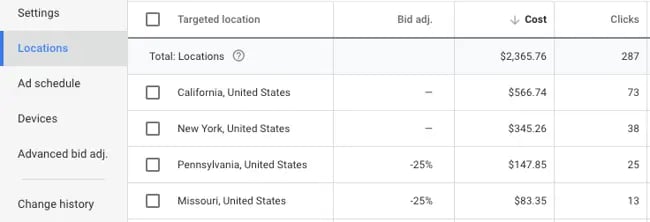
3. Mark the box for content exclusions.
Before launching a campaign on GDN, it's easy to make the mistake of skimming past the additional settings for websites with explicit content. Some advanced content settings are available for preventing your site from appearing on parked domains, sites with sexually suggestive content, sites with sensitive social issues, and more.
Google doesn't mark these boxes by default, so they must be manually selected to prevent your ads from appearing on undesirable sites.
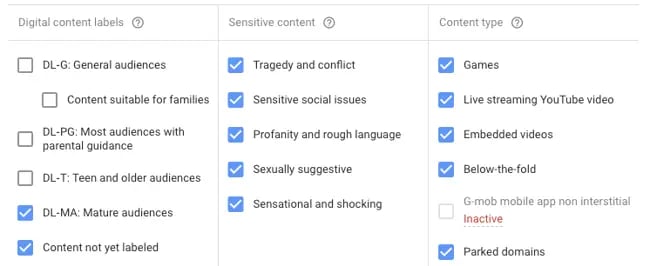
Optimizing Your Google Display Network Results
Now that we've explored targeting methods as well as specific audience-building factors, let's dive deeper into how you might optimize your GDN results.
1. Assess demographic performance, and then recalibrate if necessary.
Some of your audience demographics may be ideal for traditional marketing but could perform poorly in a digital setting. Even after setting up specific demographic and location targeting, it's important to review the performance of what hasn't been excluded. For example, there are some demographic categories (e.g., "unknown") and ages (e.g., "65+") that can become costly after launch.
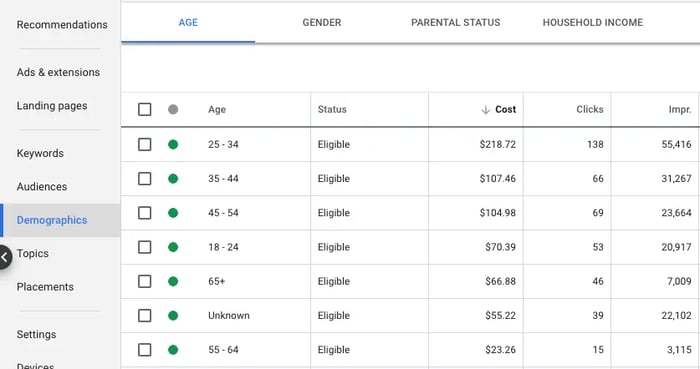
2. Assess placement performance and use those analytics to continually improve.
Google makes it easy to review where your ads are appearing on a daily or weekly basis after campaign launch. You can find this information under "Placements > Where Ads Showed."
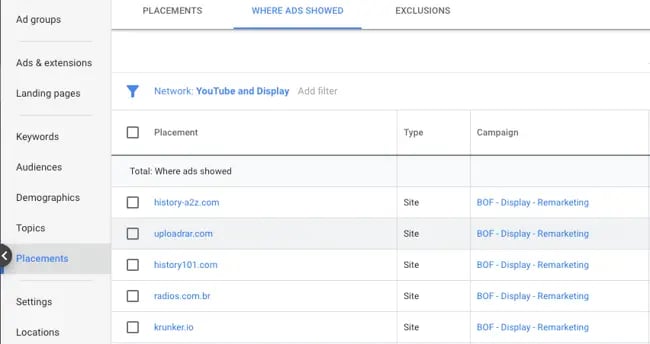
Filtering placements by unusually high spend or CTR can quickly identify websites that are more of an immediate threat to your campaign's health. If you're considering bulk exclusions, you may find it helpful to export web placements within the timeframe of "all time".
Focus on blocking the duplicate placements that yield no results, since repeat offenders are a higher priority than websites that appear once with only a few impressions. After identifying duplicates, review the relevance of these sites, how much they have spent, and whether they have led to any conversions.
3. Consider which ad style and location will yield the best results.
There are two main ad types available for a GDN campaign — standard image ads and responsive ads. Standard image ads have a number of formats, including square, rectangular, skyscraper, and banner. These ads are an image-only display option. Here's an example:

Responsive ads, on the other hand, offer a combination of text and image options that display in a variety of formats, depending on where the ad appears. The complete ad is composed of three image types, up to five short headlines, one long headline, up to five descriptions, and a business name. The short headlines and descriptions rotate to find and show the best-performing combination. Here's an example:
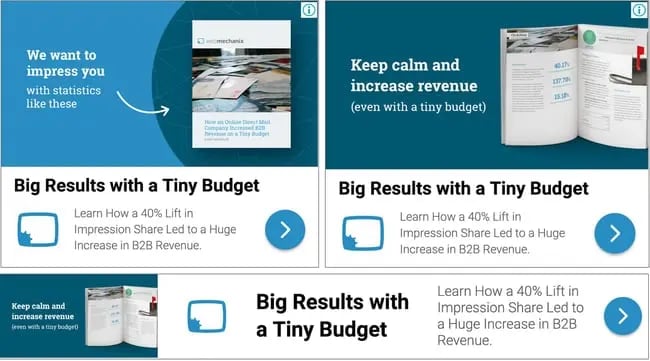
If you're limited on time, budget, or creative resources, it can be tricky to know which display ads will work best for your campaign, and you might not want to risk time testing different ones. If this is the case, it's important to note studies have shown that 300 x 250 and 728 x 90 receive more impressions than other ad formats. Half-page ads and large rectangles receive higher CTRs than other ad formats, as well. So if you're not sure where to begin, try out the rectangular formats and leaderboards!

Figure Out Whether Google Display Network Is The Right Choice For Your Business
You can amass a very powerful reach on the Google Display Network with the right attention to targeting. The network's affordability, as well as the separation from the competition, makes it a viable marketing option.
This guide has covered several audience-building and optimization factors to help you hit the ground running with Google Display Network campaigns. Whether you're just starting out or have some room for improvement, check out the custom audience capabilities to see if one might work for your next campaign.
Editor's note: This post was originally published in May 2019 and has been updated for comprehensiveness.
Google Ads












